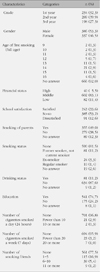Abstract
Purpose
The purpose of this study was to examine the effects of knowledge about the harmfulness of smoking and attitude toward smoking temptation for middle school students.
Methods
A survey was conducted in this study on 745 students from 12 middle schools in the Y City. Data were analyzed with SPSS/WIN 12.0 using descriptive statistics, t-test, ANCOVA, Scheffe's test and multiple regression analysis.
Results
There was statistically significant difference in knowledge about the harmfulness of smoking (F=2.88, p<.05) and attitude toward smoking (F=54.61, p<.001). And there was statistically significant difference in smoking temptations among tempting factors such as negative mood of individual (F=63.61, p<.001), positive mood of social situation (F=67.08, p<.001), habitualness (F=57.68, p<.001), weight control (F=33.01, p<.001), and others' smoking (F=73.13, p<.001).
Figures and Tables
Table 2
Subjects' Knowledge of the Harmfulness of Smoking, Smoking Attitude and Smoking Temptation (N=724)

Table 3
Subjects' Knowledge of the Harmfulness of Smoking, Smoking Attitude and Smoking Temptation in Accordance with their Gender and Age (N=724)

References
1. Back KO. A Study on the knowledge and attitudes about smoking by middle school students in Pusan. Busan: Pusan National University;2001. Unpublished master's thesis.
2. Back KO, Kang IS. A study on the knowledge and attitudes toward smoking among middle school students. J Korean Community Nurs. 2002; 13(3):417–480.
3. Chang JY. Analysis of related factors on middle school student smoking in korea. Seoul: Yonsei University;2006. Unpublished master's thesis.
4. Choi JS. The effects of smoking cessation program applying the cognitive behavior therapy. Seoul: Seoul National University;1999. Unpublished Doctor dissertation.
6. Goverment Youth Commission. Youth policy statistic. Seoul: Goverment Youth Commission;2007.
7. Han YR, Ha EH, Park HS, Lee BE. Motivation of adolescents smoking cessation: use of focus group interview. J Korean Soc Health Educ Promot. 2005; 21(1):55–71.
8. Joung MY, Park CO. A study on the factors of effecting on smoking behavior of middle and school students in city area. J Korean Public Health Assoc. 2001; 27(1):39–52.
9. Kang MO. Study on the effect of self-experimetal smoking prevention program for female high school students. Busan: Pusan National University;2005. Unpublished master's thesis.
10. Kim HO. A study on the smoking related social influence, refusal skill and nonsmoking related self-efficacy among adolescents. Korean J Child Health Nurs. 2003; 9(3):237–249.
11. Kim SY, Nam KA, Seo MA, Lee HH, Park JH. Development of school-based smoking cessation program for korean smoking Adolescents. J Korean Acad Psychiatr Ment Health Nurs. 2002; 11(4):462–473.
12. Kim SJ, Yang SO. Knowledge and attitude about smoking in middle school students. Korean J Child Health Nurs. 2002; 8(2):152–163.
13. Korea Association of Smoking and Health. Survey of smoking rate among middle and high school students. Seoul: Korea Association of Smoking and Health;2003.
14. Korea Center for Disease Control and Prevention. Smoking behaviors among Korean adlolescents: The results of youth risk behavior web-based survey 2006-2007. 2008. 11. 13. Retrieved November 13, 2008. from http://www.cdc.go.kr/kcdchome/jsp.
15. Park HM. A study on smoking and relevant factors among middle school students in Gyeonggi province. Gyeonggi: Ajou University;2003. Unpublished master's thesis.
16. Paik JB, Seo HG, Kim CH, Jang KH. The smoking rate and smoking behaviors of high school students in seoul. Inje Med J. 2002; 23(5):383–391.
17. Park NH. Predictors of stage of change for smoking cessation among adolescents utilizing the transtheoretical model. Busan: Pusan National University;2002. Unpublished master's thesis.
18. Park YI. A study on the factors affecting smoking cessation behavior of university students smoker. J Korean Soc Health Educ Promot. 2004; 10(2):229–238.
19. Park YK, Kang YJ. Behavior, knowledge and attitude on smoking of primary school children. J Korean Acad Fam Med. 1996; 17(9):798–809.
20. Plummer BA, Velicer WF, Redding CA, Prochaska JO, Rossi JS, Pallonen UE, et al. Stage of change, decisional balance, and temptations for smoking: Measurement and validation in large, school-based population of adolescents. Addict Behav. 2001; 26:551–571.
21. Lee SG, Kwon YY, Lee KH. Smoking status and the related factors of high school students. J Korean Acad Fam Med. 2000; 21(8):1042–1052.
22. Seo BY. Smoking related factors of middle school students in some area of busan city. Busan: Kosin University;2006. Unpublished master's thesis.
23. Shin SR. The study on the development of a self-regulatory efficacy promoting program and it's effect on adolescents smoking. Seoul: Ewha Woman's University;1997. Unpublished Doctoral dissertation.
24. Shin SR, Lee DS, Park JH. The effect of life smoking cessation program multidisciplinary approach. J Korean Acad Nurs. 2000; 30(1):110–121.

25. Torabi MR, Bailey WJ, Majd-Jabbari M. Cigarette smoking as a predictor of alcohol and other drug use by childern and adolescents: Evidence of the "gateway drug effect". J Sch Health. 1993; 63(7):302–306.
26. Velicer WF, DiClemente CC, Rossi JS, Prochaska JO. Relapse situations and self-efficacy: An integrativemodel. Addict Behav. 1990; 15(3):271–283.
27. World Health Organization. Guideline for the conduct of tabacco smoking surveys of the general population. Helsinki: World Health Organization;1982. 06.
28. World Health Organization. Second-hand smoke kills. Let's clear the air. 2001. 05. 31. Retrieved May 31, 2001. from http://www.paho.org/English/AD/SDE/RA/wntd-DirectorMessage.pdf.
29. Yang SO, Kim SJ, Choi EJ, Baek SS, Yang SB. Knowledge and attitude toward smoking behavior in male middle school students. J Korean Community Nurs. 2002; 13(2):387–398.




 PDF
PDF ePub
ePub Citation
Citation Print
Print





 XML Download
XML Download